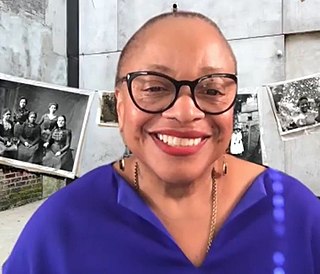Related Research Articles

Museology or museum studies is the study of museums. It explores the history of museums and their role in society, as well as the activities they engage in, including curating, preservation, public programming, and education.
Amelia Jones originally from Durham, North Carolina is an American art historian, art theorist, art critic, author, professor and curator. Her research specialisms include feminist art, body art, performance art, video art, identity politics, and New York Dada. Jones's earliest work established her as a feminist scholar and curator, including through a pioneering exhibition and publication concerning the art of Judy Chicago; later, she broadened her focus on other social activist topics including race, class and identity politics. Jones has contributed significantly to the study of art and performance as a teacher, researcher and activist.
Carrie Mae Weems is considered one of the most important contemporary artists working in text, fabric, audio, digital images and installation video, and is best known for her work in the field of photography. She achieved prominence through her early 1990s photographic project The Kitchen Table Series. Her award-winning photographs, films and videos have been shown in over 50 exhibitions in the United States and abroad, and focus on serious issues facing African Americans today, including racism, sexism, politics and personal identity.

Robert Houle is a Saulteaux First Nations Canadian artist, curator, critic, and educator. Houle has had an active curatorial and artistic practice since the mid-1970s. He played an important role in bridging the gap between contemporary First Nations artists and the broader Canadian art scene through his writing and involvement in early important high-profile exhibitions such as Land, Spirit, Power: First Nations at the National Gallery of Canada. As an artist, Houle has shown both nationally and internationally. He is predominantly a painter working in the tradition of Abstraction, yet he has also embraced a pop sensibility by incorporating everyday images and text into his works. His work addresses lingering aspects of colonialism and their effects on First Nation peoples. Houle often appropriates historical photographs and texts, repurposing and combining them with Anishnaabe language and traditionally used materials such as porcupine quills within his works.
Elaine A. King is a curator, critic, professor, and editor.

Deborah Willis is a contemporary African-American artist, photographer, curator of photography, photographic historian, author, and educator. Among her awards and honors, she was a 2000 MacArthur Fellow. She is currently Professor and Chair of the Department of Photography and Imaging at Tisch School of the Arts of New York University.
Sarah Cook is a Canadian scholar, who is based in Scotland. She is well known as a historian and curator in the field of New Media art. Cook was a Research Fellow at the University of Sunderland, where she worked with the research institute CRUMB – Curatorial Resource for Upstart Media Bliss, that she co-founded with Beryl Graham in 2000, and taught on the MA Curating course. In 2013 she was appointed as a Reader and Dundee Research Fellow at Duncan of Jordanstone College of Art, University of Dundee. As part of her role as Dundee Fellow she founded and curated LifeSpace Science Art Research Gallery in the School of Life Sciences, University of Dundee (2014-2018). She is a trustee of folly in Lancaster. In 2018 she joined the Department of Information Studies at University of Glasgow as Professor in Museum Studies. For many years, she has curated exhibitions of New Media art and was instrumental in establishing New media as an academic subject and an accepted art form.
Sandra Meigs is a Canadian visual artist. She is based in British Columbia, Canada. Her paintings have been exhibited in Canada and internationally and she is a member of the Royal Canadian Academy of Arts.
Diane Borsato is a Canadian visual artist whose work explores pedagogical practices and experiential ways of knowing through performance, intervention, video, installation, and photography. Her multidisciplinary and socially engaged works are often created through the mobilization of distinct groups of people including arts professionals, artists, and naturalists. Her work has been widely exhibited in galleries, museums and artist-run-centres across Canada and internationally, including the Vancouver Art Gallery, Power Plant Contemporary Art Gallery, The Art Gallery of York University, the National Museum of Fine Arts of Quebec, Art Metropole, Mercer Union, the Musée d'Art Contemporain in Montreal, and in galleries in the US, France, Germany, Mexico, Taiwan and Japan. Borsato was a Sobey Art Award nominee in 2011 and 2013 and the recipient of the Victor Martyn Lynch-Staunton Award in 2008 for her research and practices in the Inter-Arts category from the Canada Council for the Arts. In 2013, she was an artist in residence at The Art Gallery of Ontario where she created actions, like Tea Service(Conservators Will Wash the Dishes) and Your Temper, My Weather, that animated the collections and environments of the gallery. Borsato is an Associate Professor of Interdisciplinary Studio at the University of Guelph where she teaches in the areas of 2D Integrated Media, Extended Practices and in the MFA program. She creates advanced, thematic studio courses that explore social and conceptual practices that have included Food and Art, Special Topics on Walking, LIVE ART and Outdoor School.
Paul Greenhalgh is a writer, historian, and curator of art and design. For the last 25 years he has been a senior figure or director of a number of arts organisations, in the UK, Canada, and the USA. Since November 2010 he has been Director of the Sainsbury Centre at the University of East Anglia, UK, and Professor of Art History and Museum Strategy at UEA. He has recently become Executive Director.
Concordia University's Studio Arts Dept.
Michelle LaVallee is a Canadian curator, artist, and educator. She is Ojibway and a member of the Chippewas of Nawash Unceded First Nation in Cape Croker, Ontario. She has BFA (2000) and BEd (2004) degrees from York University in Toronto.
Elizabeth MacKenzie is a Canadian artist based in Vancouver known for her drawing, installation and video since the early eighties. MacKenzie uses drawing to explore the productive aspects of uncertainty through the use of repetition, interrogations of portraiture and considerations of intersubjective experience. Her work has been characterized by an interest in maternal ambivalence, monstrous bodies, interrogations of portraiture and considerations of the complexity of familial and other interpersonal relations.

Dr. Heather L. Igloliorte is an Inuk scholar, independent curator and art historian from Nunatsiavut.
Barry Ace (artist) is an Anishinaabe (Odawa) photographic and multimedia artist and curator from Sudbury, Ontario. Ace's work includes mixed media paintings, and mixed media textile and sculptural work that combines traditional Anishinaabe textiles and beadwork with found electrical components. Ace has a strong interest in combining traditional and contemporary technologies, aesthetics, and techniques in his artwork.
Brenda L Croft is an Aboriginal Australian artist, curator, writer, and educator working across contemporary Indigenous and mainstream arts and cultural sectors. Croft was a founding member of the Boomalli Aboriginal Artists Cooperative in 1987.
Daina Warren is a Canadian contemporary artist and curator. She is a member of the Akamihk (Cree) Nation in Maskwacis, Alberta. Her interest in curating Aboriginal art and work with Indigenous artists is at the forefront of her research.
Pamela Edmonds is a Canadian visual and media arts curator focused on themes of decolonization and the politics of representation. She is considered an influential figure in the Black Canadian arts scene. Since 2019, Edmonds has been the senior curator of the McMaster Museum of Art.
Julie Crooks is a Canadian curator, researcher and instructor. She has been the head of the department of Arts of Global Africa and the Diaspora at the Art Gallery of Ontario since its founding 2020.

Mike Tooby is an independent curator and researcher based in Cardiff, Wales. His interests lie in integrating the practices often separated in curating in the arts and heritage settings: research, display, promotion, participation and learning. His own practice centres on curating in collaborative or site-specific contexts, where negotiating and celebrating relationships with audiences are at the core of projects.
References
- ↑ "Faculty of Fine Arts – Profs: J. Fisher". York University. Retrieved 5 September 2010.CS1 maint: discouraged parameter (link)
- ↑ "Fellowships in Canadian Art". National Gallery of Canada. Archived from the original on 31 December 2010. Retrieved 5 September 2010.